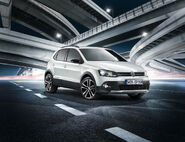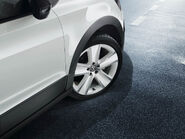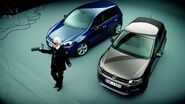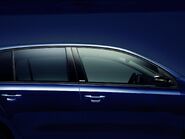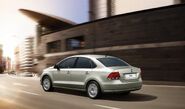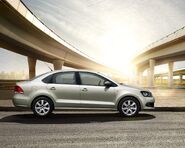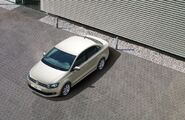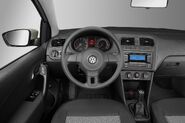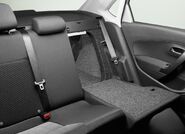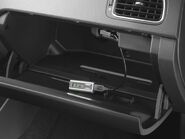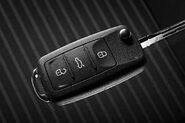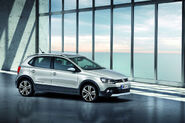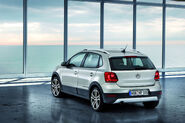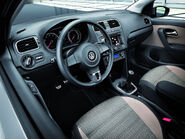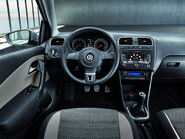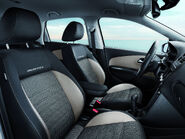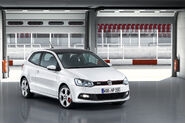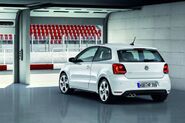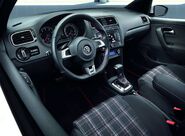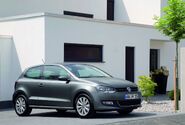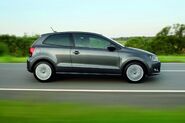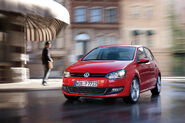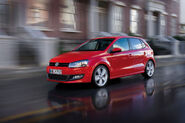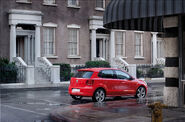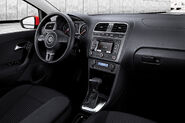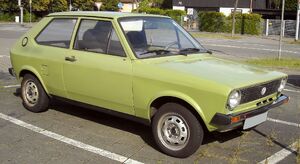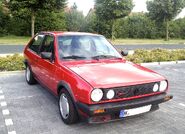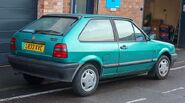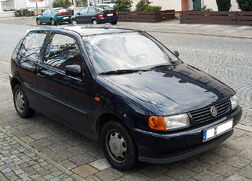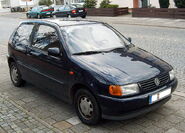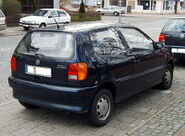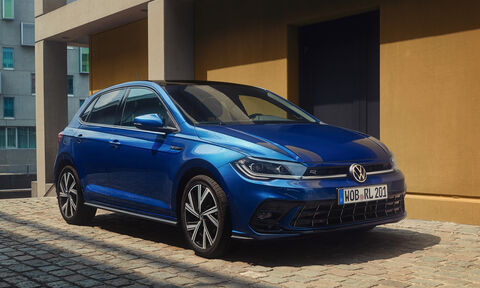
The MK6 Polo, designed by Klaus Bischoff
The Volkswagen Polo is a supermini car (B-segment) produced by the German car manufacturer Volkswagen since 1975. It is sold in Europe and other markets worldwide in hatchback, saloon, and estate variants throughout its production run.
Recent Changes
- For 2012, Volkswagen will begin offering the CrossPolo Urban White Edition for the EU market. The special edition model combines a unique shade of white paint with 17-inch alloys painted either white or black, with black roof rails and dark tinted glass aft of the B-pillar. The interior features black and light gray sports seats in cloth and Alcantara, with black headliner and trim and silver top-stitching on the controls. The Urban White will be offered in a choice of four gasoline and three common-rail diesel engines, with prices starting at €18,975.[1]
- Volkswagen adds a new trim package in late December 2010 called the Polo STYLE. The STYLE special editions, limited only to Germany, of the Polo come with a money-saving options package that includes light-alloy wheels, fog lamps, tinted side and rear windows and STYLE badging. Anther package, the STYLE-Plus, also adds a sunroof or panorama roof as well as new set of alloys. The VW Polo STYLE is priced starting at €14,075 in Germany - an advantage of €1,885 over buying the options separately. The STYLE-Plus package saves consumers up to €865.
- On June 2, 2010, Volkswagen revealed details and images of the Volkswagen Polo sedan in Russia ahead of its 2010 Moscow Motor Show debut. It is 4.38 meters (172 inches) long, 1.7m (66.9 inches) wide, 1.46m (57.5 inches) high with a wheelbase of 2.55m (100 inches). Among the engine options will include VW's 1.6-litre Otto engine producing 105-horsepower. It can be combined with either a 5-gear manual gearbox or a 6-gear automatic gearbox with sequential shift function (Tiptronic). The Polo sedan will be available in three trim levels - Trendline, Comfortline and the range-topping Highline that comes with standard side air-bags and ESP. Standard toys will include height-adjustable driver's seat, an onboard computer, immobiliser, power windows and dual front airbags. Pricing is expected to start at (US$12,800 / €10,400). [2]
- Alongside the Polo GTI, VW also debuted the new CrossPolo at the 2010 Geneva Show. [3]
- The 2010 Geneva Motor Show will hold the launch of the Polo GTI hot hatch. Packing the SEAT Ibiza Cupra's 178 hp/184 lb-ft turbo- and supercharged 1.4-liter gasoline-powered four, the GTI accelerates to 60 in 6.9 seconds on to a top speed of 163 mph. Power is routed to VW's XDS differential via a seven-speed dual-clutch gearbox.[4]
- The 2009 Frankfurt Motor Show plays host to the unveiling of the 3 door variant of the Volkswagen Polo.[5]
- At the 2009 Geneva Motor Show, Volkswagen unveiled the fifth-generation Polo. For the first time as well, the new Polo will feature VW's 7-speed DSG transmission. [6]
History
There have been four separate series of the Polo, designated Mark I to Mark IV. Each generation was facelifted mid way through its production, with the updated versions known by an addition of the letter F to the model number, e.g. Mark IIF.
The body style has been varied through the life of the car, but the most widely available form has always been a hatchback; indeed the Mark I saloon was branded as a Volkswagen Derby.
Volkwagen's products are not the same in all territories and a number of different models have been sold under the name. For example the Volkswagen Polo Playa hatchback sold in Southern Africa in the late 1990s was a rebadged SEAT Ibiza which was quite different to the Mk III Polo sold in Europe at the same time. The current saloon is only available in China, Latin America and South Africa and other Southern Africa countries.
Position in the Volkswagen range
On its introduction in 1975, the Polo was Volkswagen's second front wheel drive hatchback model, fitting into the range beneath the Golf, which had been launched the previous year. It remained the smallest model in the Vokswagen range until 1998, when the Volkswagen Lupo was introduced. The Polo is still Volkswagen's second smallest model, larger than the Fox and smaller than the Golf. (In North America, the Golf – now sold there as the Rabbit – is the smallest Volkswagen available, the Polo never having been sold in this territory.)
Over the generations, as with many other long-lived car brands, the Polo's size has increased, and the latest incarnation of the Polo is actually larger than the original Golf Mark I.
The current version is mechanically very similar to the SEAT Ibiza and Škoda Fabia, being based on a standard VW Group chassis used for a large number of models.
In India, Volkswagen polo was positioned below the Skoda Fabia through its aggressive pricing. But when the Skoda launched the refreshed fabia, the czech maker has reduced the price considerably. Now polo sits over the fabia range. The pricing details of Skoda Fabia and Volkswagen Polo as per the links provided
Engine and Transmission
Volkswagen Polo is available in both Petrol and Diesel Engine. The Petrol variant of Volkswagen Polo comes in two engine capacity- 1.2 L and 1.6L. The 1.2 L petrol engine, 1198 cc is packed with 5 Speed Manual Gearbox that offers very smoother shifting of gears and ensure less friction. This 1.2 L extra powerful engine of Volkswagen Polo is very fuel efficient and a good performer. This impressive engine produces a Maximum Power of 75 PS at 5400 rpm and a Maximum Torque of 110 Nm at 3750 rpm and delivers good acceleration so that car can cross 100kmph mark in 14.2 seconds and can touch the top speed mark of 162.9kmph.
The sports version of Volkswagen Polo too, which will be equipped with the 1.6L petrol engine with a displacement of 1598cc has a 5 Speed Manual Transmission. This highly powerful engine of Volkswagen Polo offers an impressive power of 105 PS at 5250 rpm and a maximum torque of 153 Nm at 3750 rpm. This engine is more powerful and it offers better acceleration in comparison to the previous one. The car can touch 0-100 kmph sprint in just 11.1 seconds with a top-speed of 183.8 km/hr.
The diesel variant comes in only one model, Volkswagen Polo 1.2L Diesel engine. This 1.2 L, 1199 cc diesel engine is also packed with 5 Speed Manual Gearbox. The diesel variants are very fuel economical and give a very smooth drive without any vibration. The highly powerful diesel engine produces a Maximum Power of 75 PS at 4200 rpm and a Maximum Torque of 180 Nm at 2000 rpm and delivers great acceleration so that the car can cross 100kmph mark in just 14.4 seconds and it can touch the top speed mark of 164.1kmph.
Performance versions and motorsport
Volkswagen pioneered the so-called hot hatch genre of high performance hatchbacks with the Golf GTI in 1975, and has produced a number of performance versions of the Polo. The first of these was the Polo GT version of the Mark IF.
The Mark II and IIF were available as supercharged G40 models. The GT G40 with its 1.3L 85 kW / 115 hp could reach 100 km/h (62 mph) in 8.1 secs from standstill and had maximum speed of 196 km/h (122 mph) it was used by Volkswagen to set a number of world endurance speed records, such as the 1300 cc class records for speed over 24 hours and speed over a distance of 5000 km.
The fastest version of the Mark III on the UK market was the 16-valve model, with 100 PS. A 120PS / 88kW GTI model was also produced, but only in a limited edition in Germany, and this was the first time the GTI label had been used for a Polo. A GTI version of the Mark IIIF Polo, with a 125hp / 92kW 1.6 engine, was also produced.
In 2004 Volkswagen Individual, a specialist division of Volkswagen, produced a limited number of (Mark IV Polo) Club Sports with a 1.8T 180hp/132kW engine. Available only in Germany, this was based on the one-make racing series Polo Cup Racer hatchback. The Club Sport came with a roll cage inside the vehicle and Recaro racing seats as standard. A GTI version of the current (Mark IVF) was launched in 2006. This features styling similar to that of the contemporary Golf GTI and a 20V, turbocharged 1.8l engine with 150bhp. It has a 0-60 mph time of 8.2 seconds and a top speed of 134mph.
Volkswagen Individual have also engineered an even faster Polo called the Polo GTI Cup Edition, available with the same 1.8T engine abeit with 180hp/130kW its claimed 0-100km/h (0-62mph) is 7.5sec & a claimed top speed of 225km/h.
Volkswagen Racing in South Africa rallyed a four wheel drive Mark IVF Polo which shared some components with its sister World Rally Championship (WRC) Skoda Fabia; the S2000 has a 2.0L 191 kW/260 hp engine.
Mark IV Polos have been entered into the Junior World Rally Championship (JWRC).
There have been a number of one make race series for the Polo, starting with the Volkswagen Polo G40 Cup for MkII and MkIIF G40 versions. The current Polo Cup championship for 105 bhp cars is a support race at rounds of the DTM touring car championship.
Related models
The first Polo was effectively a rebadged version of the Audi 50, which was discontinued in 1978 as Audi concentrated on larger luxury models. The Mark I and Mark II versions of the Polo were then standalone models in the Volkswagen range.
With the expansion of the Volkswagen group in the 1990s SEAT and Skoda were aqquired, and the platform used for the Polo was shared with other models.
The Mark III Polo shared its platform with the Mark 2 SEAT Ibiza. The Ibiza was actually launched before the Polo, and shared essentially all its mechanicals, the dashboard and other interior components, although there were no body panels shared between the two cars. The saloon and estate versions of the Mark III Polo were actually re-badged SEAT Cordoba models, and had no body panels in common with the Polo hatchback. The SEAT Inca and Volkswagen Caddy vans were also based on this model. The Volkswagen Lupo and SEAT Arosa were also based on a shortened version of the Mark III Polo platform.
The Mk IV Polo continued this trend of platform sharing, with the Skoda Fabia and Mark 3 SEAT Ibiza both being developed on the same platform and featuring several of the same engines.
Tuners cashed in on the popularity of the Polo at the time of release. For example, in the mid-Eighties, Frankfurt-based prestige tuner Buchmann devised a modification program for the car, based upon the rainbow colours and with a unique bodykit.
Bodystyles
The first Polos were hatchbacks, with the saloon being marketed as the Volkswagen Derby.
On the arrival of the Mark II model the saloon was renamed the Volkswagen Polo Classic and the hatchback style was renamed as a coupé, the Volkswagen Polo Coupé. A new estate / station wagon shape became, unusually for an estate, the commonest model of the range in European markets. In some markets it was referred to as the Volkswagen Polo Wagon, but some reviewers at the time considered it to be shaped "like a van".
From the Mark III onwards, the range was more straightforwardly conventional, including unambiguous saloon, hatchback, and estate models.
Bodystyle summary
- Three door hatchback (all versions) - the Mark II and Mark IIF were available in two separate 3-door hatchback styles, one of which was badged as a coupé
- Two door saloon (Mark I, Mark IF, Mark II, Mark IIF)
- Four door saloon (Mark III, Mark IIIF)
- Five door hatchback (Mark III, Mark IIIF, MarkIV, Mark IVF)
- Five door estate (Mark III, Mark IIIF)
- Five door crossover SUV-style (2WD) hatchback (Mark IV, Mark IVF)
Mechanical layout
The Polo is a compact car, with a traditional transversely mounted engine and front wheel drive. Mark I Polos only came with four-cylinder petrol engines, but for the Mark II a diesel engine was offered for the first time, although only in certain markets, others having to wait until the launch of the Mark III. The current range includes a variety of three- and four-cylinder petrol and diesel engines.
Early versions used four speed manual transmission, whilst the current car is available with either five-speed manual or four-speed automatic transmission. The suspension system on all models uses a fully independent MacPherson strut front suspension, whilst the rear suspension uses a semi independent system with trailing arms and a torsion beam axle. Most models use disc brakes at the front and rear drum brakes, although some recent models have all round disc brakes.
Mark I (1975-79)
- Main article: Volkswagen Polo Mk I
The first Polo, a rebadged version of the Audi 50, was introduced in 1975 and was produced until October 1981 with over 500,000 Polos sold worldwide.
The differences between the Audi and Volkswagen models were minor, with the Polo being cheaper and much more basic. The two cars were initially sold along side each other, but the Audi 50 never sold as well, and was withdrawn in 1978. The Polo was manufactured at the Volkswagen plant in Wolfsburg.
In 1977, the Derby saloon was released, which was simply a Polo, identical to the hatchback from the C-pillar forward, with a large boot attached (an Audi proposal, but which was never sold by them).
The Mark I Polo was available with the following engines:
- 895 cc, 4 cylinder petrol engine 40 bhp (30 kW; 41 PS) (hatchback only)
- 1093 cc 4 cylinder petrol engine 50 PS (37 kW)
- 1272 cc, 4 cylinder petrol engine (Polo GT, Derby sedan models, Audi 50 only)
Different levels of compression were used on each size to achieve different power outputs, and the variations are numerous, often differing depending on the country of sale, ranging from 35 to 60 PS (26 to 44 kW).
Mark IF (1979-81)
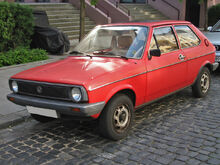
1979 Volkswagen Polo Mk1 facelift
The Mark I Polo and Derby were facelifted in 1979 (to Mark IF) with plastic bumpers, a different front grille and a revised dashboard. The round headlights of the Derby were replaced with square ones, bringing it in to line with the similar (but larger) Golf-based Jetta saloon.
Mark II (1981-90)
- Main article: Volkswagen Polo Mk II
| Mark II and Mark IIF (86C) | |
|---|---|
| Volkswagen | |
| aka | Volkswagen Derby |
| Production | 1981–90 (Mark II) 1990–94 (Mark IIF) |
| Class | {{{Class}}} |
| Body Style | 2-door estate 3-door hatchback 2-door saloon |
| Length | {{{length - type here}}} |
| Width | {{{Width - type here}}} |
| Height | {{{Height - type here}}} |
| Wheelbase | {{{wheelbase - type here}}} |
| Weight | {{{Weight - you get the point}}} |
| Transmission | {{{transmission + drive}}} |
| Engine | {{{engine}}} |
| Power | {{{Horsepower and Torque rating}}} |
| Similar | {{{similar (competition)}}} |
| Designer | {{{Designer (lead designer if it was a team effort)}}} |
A revised model (Mark II) was introduced in October 1981, with the major change being the introduction of a third body style with a steep (almost vertical) rear window, in addition to a version resembling the original Mark I shape with a diagonal rear window. These two body styles were called the Wagon (in some markets) and Coupé respectively, although in fact both were three-door hatchbacks, and in some markets the Wagon designation was not used, with that car being simply the "Volkswagen Polo" without a suffix. The sedan version was now called the Polo Classic, and the Derby name became extinct. Production was expanded to Spain in the mid 1980s following Volkswagen's takeover of SEAT.
The Mark II Polo was used extensively by Volkswagen to develop future innovations, for example supercharging in the GT G40 version. A G-supercharger would later be used on the larger and more technically challenging G60 engine used in the Golf and Corrado.
A fuel efficient 2-cylinder diesel was prototyped in the mid 1980s with a G40 supercharger to overcome its small capacity, although this did not make it to production. A high fuel efficiency model which did make production was the Formel E (E for Economy), introduced in 1983. This used a high compression 1272 cc engine, taller gear ratios and an early stop-start ignition system (called "SSA") which would cut the engine when idle for more than two seconds to save fuel whilst temporarily stopped in traffic, and re-start the engine on moving the gear lever to the left in neutral. Similar systems were later used on the Mark III Golf and various systems from other car manufacturers.
The Mark II was available with the following engines:
- 1093 cc 4 cylinder petrol engine (1981-83)
- 1272 cc 4 cylinder petrol engine. (1981-)
- 1043 cc 4 cylinder petrol engine (1983-)
- 1272 cc 4 cylinder petrol engine with fuel injection and equipped with a catalytic converter. (1983-)
- 1272 cc 4 cylinder supercharged petrol engine with 113 PS (83 kW) (GT G40 version 1987 only)
- 1.3 L 4 cylinder diesel engine (1986-)
- 1.4 L 4 cylinder diesel engine (1990-)
Mark IIF (1990-94)
A facelift in 1990 (to Mark IIF) saw square headlights, bigger bumpers and a new interior (dashboard and door trim). The three different body styles were maintained. As well as the cosmetic differences, under the skin the car received modifications to the chassis, suspension and brakes. The new Polo still had the 4-cylinder engine but now as well as the carburetor 1.0 L, a fuel injection model was available with single-point injection and all engines came standard with a catalytic converter to combat tightening European laws on car emissions. The saloon was only produced in Spain, and production of it ceased in 1992.
At the time of launch of the Mark IIF Polo, the highest performance model was the Polo GT. This featured a multi-point fuel injected version of the 1272cc engine. This produced 75bhp and had a quoted top speed of 107mph. 0-60 figures from stand still stood at 11.1 seconds. Defining features of the GT include red piping in the bumpers, black overhead cloth, a rev counter and a red "GT" badge in the grille. This was succeeded by the launch of the G40 in May 1991, displacing the GT as the most powerful Polo at the time.
Soon after the launch of the Mark IIF, another sporting model was added to the range — a new version of the supercharged G40, now as a full production model in all markets rather than the limited batch of Mark II G40s. As with the previous model, Volkswagen Motorsport modified G40 Cup cars were sold for racing in a one-make series, the Volkswagen Polo G40 Cup. Features that define the G40 from other Polo models at the time (on top of the GT) include a bee-sting aerial, BBS cross-spoke alloy wheels and front and rear red "G40" badges.
Gallery
Mk III (1994-2000)
- Main article: Volkswagen Polo Mk III
| Mark III (6N) and Mark IIIF (6N2) | |
|---|---|
| Volkswagen | |
| aka | {{{aka (Type here, not up there)}}} |
| Production | 1994–2000(Mark III) 2000–02(Mark IIIF) |
| Class | {{{Class}}} |
| Body Style | 3-door hatchback 5-door hatchback 4-door saloon 4-door estate FF 6N |
| Length | {{{length - type here}}} |
| Width | {{{Width - type here}}} |
| Height | {{{Height - type here}}} |
| Wheelbase | {{{wheelbase - type here}}} |
| Weight | {{{Weight - you get the point}}} |
| Transmission | 5 speed manual FWD, 4 speed autmatic FWD |
| Engine | {{{engine}}} |
| Power | {{{Horsepower and Torque rating}}} |
| Similar | {{{similar (competition)}}} |
| Designer | {{{Designer (lead designer if it was a team effort)}}} |
The Mark III Polo "6N" appeared in 1994, and was a completely new model (on a new chassis), available as 3- and 5-door hatchback versions. It shared its platform with the SEAT Ibiza Mark II. This platform actually used the floorpan of the Volkswagen Golf Mark III (a multitude of mechanical parts and all of the suspension components were interchangeable among the three models). Although the dashboard and a number of mechanical components, including engines, were shared with the Ibiza, outwardly the two cars were different, with no shared body panels.
The saloon and estate versions of the Mark III were essentially rebadged SEAT Cordobas, which were launched a year earlier. They were referred to internally by Volkswagen as "6KV", and shared body panels with the SEAT model rather than the Polo hatchback models, with some cosmstic alterations such as new rear and front bumpers and headlights. The Volkswagen Caddy 9K van also shares the same platform and front-end styling as the 6KV models.
The Volkswagen Lupo and SEAT Arosa city cars were based on a shortened version of the 6N platform, and shared many components.
The car was available with the following engines:
- 1043 cc 4 cylinder petrol engine 45 PS (33 kW) (1995-97)
- 1272 cc 4 cylinder petrol engine 55 PS (40 kW)(1995-96)
- 1.6 L 4 cylinder petrol engine.
- 1.4 L 4 cylinder petrol engine (1996-)
- 999 cc 4 cylinder petrol engine 50 PS (37 kW) - all-new aluminium block multi-point injection (1997-)
- 1.6 L 4 cylinder petrol engine 100 PS (74 kW) (6K saloon and estate models only)
- 1.6 L 4 cylinder petrol engine 75 PS (55 kW) (6K saloon and estate models only)
- 1.9 L 4 cylinder diesel engine 64 PS (47 kW) (6K saloon and estate models only)
Mark IIIF (2000-02)
The Mark IIIF was released in 2000, with the hatchback models featuring updated styling including new headlights and bumpers and an all new interior based on that of the Lupo. Although the car was similar in appearance to the Mark III, Volkswagen claimed that 70% of the components were new. The bodyshell was fully galvanised and stiffened but not fully redesigned, although some panels were changed. Power steering, anti-lock brakes and twin airbags were made standard. The saloon and estate versions received the new interior, but not the full exterior facelift. Also, the 3-cylinder 1.4 TDI engine was introduced for the 3 and 5-door hatchbacks. The Mark III Polo Classic is still sold in Latin America.
Awards
- 1999 Used Car Buyer Greatest Used Car Buy Awards Best Economy Car
- 1998 Top Gear Magazine Top Cars - Best Supermini
- 1997 Which? Magazine Best Buys - Best Supermini
- 1997 Auto Express New Car Honours - Best Supermini
- 1997 Complete Car of the Year Awards - Best Supermini
Polo Playa (1996-2002)
- Main article: Volkswagen Polo Playa
The Volkswagen Polo Playa was a model for the South African market. It was sold instead of the European Polo Mark III from 1996 until 2002, and was effectively a rebadged SEAT Ibiza Mark II. In 2002, the Mark IV Polo was adopted in South Africa, and the separate Polo Playa model was dropped.
Gallery
Mark IV (2001-05)
- Main article: Volkswagen Polo Mk IV

| |
| Mark IV (9N) and Mark IVF (9N3) | |
|---|---|
| Volkswagen | |
| aka | {{{aka (Type here, not up there)}}} |
| Production | 2002–05 (Mark IV) 2005–present (Mark IVF) |
| Class | Supermini |
| Body Style | 3-door hatchback 5-door hatchback 4-door saloon FF 9N |
| Length | {{{length - type here}}} |
| Width | {{{Width - type here}}} |
| Height | {{{Height - type here}}} |
| Wheelbase | {{{wheelbase - type here}}} |
| Weight | {{{Weight - you get the point}}} |
| Transmission | 5 speed Manual 4 speed Automatic, FWD |
| Engine | 1.9L 4 cylinder TDI |
| Power | {{{Horsepower and Torque rating}}} |
| Similar | Mazda 2 Toyota Yaris Mitsubishi Colt Suzuki Swift |
| Designer | {{{Designer (lead designer if it was a team effort)}}} |
Unveiled in September 2001, the all-new Mark IV ("9N") model was put on sale in early 2002. It shares its platform with the SEAT Ibiza Mark 3 and Škoda Fabia. The car is all new from the Mark III, and bears more structural resemblance to the "6KV" than the "6N"; outwardly the most recognisable change is the use of quad round headlights similar to the Lupo's.
The car was available with the following engines:
- 1.2 L three cylinder 9-Valve petrol engine with 55 PS (40 kW)
- 1.2 L three cylinder 12-Valve petrol engine with 64 PS (47 kW)
- 1.4 L 4-cylinder 16-valve petrol engine with 75 PS (55 kW)
- 1.4 L 4-cylinder 16-valve petrol engine with Fuel Stratified Injection 86 PS (62 kW) (FSI-badged model)
- 1.4 L 4-cylinder 16-valve petrol engine with 100 PS (74 kW) (16V-badged model).
- 1.9 L 4-cylinder TDI PD (Pumpe Düse) diesel engine with 100 PS (74 kW)
- 1.4 L 3-cylinder TDI PD (Pumpe Düse) diesel engine with 75 PS (55 kW).
- 1.9 L 4-cylinder TDI PD (Pumpe Düse) diesel engine with 130 PS (96 kW).
There was also a mini SUV version of the Polo with "off-road" styling named Polo Fun (Polo Dune in the United Kingdom), but despite its appearance the car was never available with four wheel drive. A saloon version, called Polo Classic, was produced in Brazil, South Africa and China and exported to the rest of Latin America and to Australia. The Chinese version has the distinction of being the first Chinese-built car to be produced with right hand drive.
Volkswagen Racing rallyed a Polo S1600 in the 2003 Junior WorldRally Championship, winning the Turkish round. The Super 1600 developed 165 kW/215 hp to its front wheels.
Mark IVF (2005-2009)
In 2005, the Mark IVF ("9N") was face-lifted with new Volkswagen Passat-style headlights and tail lights, and a different hatch. The Mark IVF was designed by Walter de'Silva. In the UK, the Mark IVF is available in 6 different trim levels, ranging from the basic "E" model to the "GTI". The engine range is as for the Mark IV, with the addition of the following engine:
- 1781cc, turbo-charged 4- cylinder, 20V petrol engine 150 PS (GTI models only)
A mini SUV-styled (but still two wheel drive) CrossPolo version of the Mark IVF was also produced as a successor to the Mark IV-based Polo Fun.
Fifth generation (6R/6C/61; 2009)
Main article: Volkswagen Polo Mk5
Volkswagen launched the fifth generation Polo (internal designation Typ 6R) at the Geneva Motor Show in March 2009. For the first time in Polo's history, the car was declared European Car of the Year, for 2010. The Polo was also declared 2010 World Car of the Year at the New York International Auto Show in April 2010. It also won What Car? Supermini of the Year 2010, as well as being awarded Japan Import Car of the Year for 2010–2011.
It shares its platform with the SEAT Ibiza Mk4 and the Audi A1. Production for the UK market started in August 2009, with first deliveries beginning in October 2009. The Polo Mark V is 44 mm longer, 32 mm wider, and sits 13 mm lower to the road than the previous generation Polo. Boot capacity is increased by 10 L to 280 L of storage space with 952 L with the seats folded down. The car is 7.5% lighter than its predecessor. The Polo has thorcic airbags and has been awarded a five-star Euro NCAP crash impact rating.
Saloon versions
Volkswagen Vento/Polo Sedan
In 2010, a saloon based on the Polo Mk5 platform was developed for launch in India and Russia. This saloon is known as the Vento or Polo Sedan, depending on the country.[17][18] It has a length of 4,384 mm, increased wheelbase (2,552 mm) and ground clearance (168–170 mm), and had one petrol engine (1.6-litre, four-cylinder, 105 PS; coupled with either five-speed manual or six-speed automatic gearbox) and one diesel engine (1.6-litre, turbocharged four-cylinder common-rail, 105 PS; only five-speed manual gearbox) options available.
In several markets, it is succeeded by the Virtus, while some markets such as Mexico offered the Virtus alongside the Vento for the purpose of keeping a budget-friendly option. In Russia, the Polo Mk5-based Polo Saloon is succeeded by the Škoda Rapid-based Polo liftback.
Volkswagen Ameo
The Ameo is another saloon based on the Polo Mk5 platform. It was developed for the Indian market and launched in June 2016. It is a notchback saloon heavily derived from the hatchback body of the Polo, retaining its shorter wheelbase and the rear doors, unlike the larger Vento/Polo Saloon.
Sixth generation (AW/BZ; 2017)
The sixth-generation Polo was first unveiled in Berlin on 16 June 2017, and launched in late 2017. Based on the Volkswagen Group MQB A0 platform, it is claimed to carry improvements in cabin space, engines, and interior technology. It is the first Polo generation that is not available with a 3-door body style, in order to cut costs.
Boot space has increased by about 25% from 280 to 351 L. Optionally, it now features the second-generation version of the Active Info Digital Display Cockpit, a first in its class. As standard, the car comes with front collision detection, blind-spot assist, and emergency stopping. The car is said to be extremely customizable, available in 14 exterior colours and 17 dashboard colours.
Production for all right-hand drive markets are allocated to the Volkswagen plant in Uitenhage/Kariega, South Africa. The South African plant is also the sole producer of the Polo GTI.
Facelift
In April 2021, the restyled version of the sixth-generation Polo was revealed for the European market. It gained a redesigned front end, featuring reshaped headlights and an LED light bar on the grille. A matrix LED setup is optional for the first time in a Polo. The rear end now adopts wider LED taillights extending onto the tailgate. With the facelifted version, the Polo comes with a fully digital instrument cluster as standard. The dashboard also received a redesigned touch climate control.
Trivia
- The Polo name has been a source of speculation. Some people believed it was a reference to polar winds, in keeping with Volkswagen's penchant for naming its watercooled cars after winds and currents, but many fans insist that it is in fact a pun on the Golf's name, because "golf" and "polo" are both English-language words for upper-class sports. The fact that the Polo's original saloon derivative was named the Derby gives more credence to the latter theory, since derby, like polo, refers to an equestrian sport.
- Some Polo models from the 1970s and 1980s used the emblem of the city of Wolfsburg on the steering wheel hub rather than the normal Volkswagen logo seen today. This was typical of older Volkswagens, such as the Beetle.
- In 2004, a viral video advertisement was widely circulated on the internet. In it, a suicide bomber drives a Polo to his target; the bomb is detonated but the car remains completely intact, to the extent that the event goes unnoticed by bystanders. The ad finally displays the Polo's established tagline, Small but tough. The ad was created by the secretive, London based, freelance advertising partnership, Lee and Dan, who claimed it was not intended to be viewed by the public. Despite legal action against the partnership by Volkswagen in 2005[1], there are rumours the ad was secretly commissioned by the company as a form of Viral marketing.
- In the What Women Want survey conducted by the RACV in 2003, the Polo is the most popular choice among women buying a Volkswagen.
- In 2010, the Mark V Polo won Best City Car by Australian auto reviewer Drive.
Main Competitors
- Nissan Micra
- Hyundai Getz
- Mitsubishi Colt
- Toyota Yaris
- Honda Fit/Jazz
- Tata Indica
- Hyundai i20
- Chevrolet Aveo
See Also
| Volkswagen car timeline, European market, 1950-1979 - [edit] | Next -> | |||||||||||||||||||||||||||||
| Type | 1950s | 1960s | 1970s | |||||||||||||||||||||||||||
| 0 | 1 | 2 | 3 | 4 | 5 | 6 | 7 | 8 | 9 | 0 | 1 | 2 | 3 | 4 | 5 | 6 | 7 | 8 | 9 | 0 | 1 | 2 | 3 | 4 | 5 | 6 | 7 | 8 | 9 | |
| Economy car | (1938) Type 1 - Beetle | |||||||||||||||||||||||||||||
| Supermini | Polo I | |||||||||||||||||||||||||||||
| Derby I | ||||||||||||||||||||||||||||||
| Small family car | Golf I | |||||||||||||||||||||||||||||
| Type 3 | ||||||||||||||||||||||||||||||
| Large family car | Type 4 | |||||||||||||||||||||||||||||
| K70 (NSU) | Passat I | |||||||||||||||||||||||||||||
| Coupé | Karmann Ghia | Scirocco I | ||||||||||||||||||||||||||||
| Van | Type 2 - T1 | Type 2 - T2 | ||||||||||||||||||||||||||||
</noinclude>
| <- Previous | Volkswagen car timeline, European market, 1980s-present - [edit] | ||||||||||||||||||||||||||||||
| Type | 1980s | 1990s | 2000s | ||||||||||||||||||||||||||||
| 0 | 1 | 2 | 3 | 4 | 5 | 6 | 7 | 8 | 9 | 0 | 1 | 2 | 3 | 4 | 5 | 6 | 7 | 8 | 9 | 0 | 1 | 2 | 3 | 4 | 5 | 6 | 7 | 8 | 9 | ||
| City car | Lupo | Fox | |||||||||||||||||||||||||||||
| Supermini | Polo I | Polo II | Polo III | Polo IV | |||||||||||||||||||||||||||
| Derby I | |||||||||||||||||||||||||||||||
| Small family car | Type 1 (Beetle) | ||||||||||||||||||||||||||||||
| Golf I | Golf II | Golf III | Golf IV | Golf V | |||||||||||||||||||||||||||
| Jetta I | Jetta II | Vento | Bora | Jetta V | |||||||||||||||||||||||||||
| Large family car | Passat I | Passat II | Passat III | Passat IV | Passat V | Passat VI | |||||||||||||||||||||||||
| Executive car | Phaeton | ||||||||||||||||||||||||||||||
| Coupé | Scirocco I | Scirocco II | Scirocco III | ||||||||||||||||||||||||||||
| Corrado | New Beetle | ||||||||||||||||||||||||||||||
| Van | Caddy 14 | Caddy 9U / 9K | Caddy 2K | ||||||||||||||||||||||||||||
| Type 2 (T3) | Caravelle/Multivan (T4) | Caravelle/Multivan (T5) | |||||||||||||||||||||||||||||
| Compact MPV | Golf Plus | ||||||||||||||||||||||||||||||
| Touran | |||||||||||||||||||||||||||||||
| Large MPV | Sharan | ||||||||||||||||||||||||||||||
| Off-roader | Tiguan | ||||||||||||||||||||||||||||||
| Touareg | |||||||||||||||||||||||||||||||
| <- Previous | Volkswagen car timeline, South American market, 1980s—present [edit] | |||||||||||||||||||||||||||||
| Type | 1980s | 1990s | 2000s | |||||||||||||||||||||||||||
| 0 | 1 | 2 | 3 | 4 | 5 | 6 | 7 | 8 | 9 | 0 | 1 | 2 | 3 | 4 | 5 | 6 | 7 | 8 | 9 | 0 | 1 | 2 | 3 | 4 | 5 | 6 | 7 | 8 | 9 | |
| Economy car | Gol / Voyage / Gacel (I) | Gol / Amazon / Senda (IF) | Gol (II) | Gol (III) | Gol (IV) | |||||||||||||||||||||||||
| Parati (I) | Parati (IF) | Parati (II) | Parati / Gol Country (III) | Parati / Gol Country (IV) | ||||||||||||||||||||||||||
| Supermini | Polo Classic (III) | |||||||||||||||||||||||||||||
| Polo (IV) | Polo (IVF) | |||||||||||||||||||||||||||||
| Supermini | Fox / CrossFox | |||||||||||||||||||||||||||||
| SpaceFox / Suran | ||||||||||||||||||||||||||||||
| Small family car | Pointer | Golf III | Golf IV | |||||||||||||||||||||||||||
| Apollo | Logus | Bora | Vento | |||||||||||||||||||||||||||
| Large family car | Passat I | Passat III | Passat IV | Passat VI | ||||||||||||||||||||||||||
| Santana / Carat / Quantum | ||||||||||||||||||||||||||||||
| Panel van | Caddy III | |||||||||||||||||||||||||||||
| Pickup truck | Saveiro (I) | Saveiro (IF) | Saveiro (II) | Saveiro (III) | Saveiro (IV) | |||||||||||||||||||||||||
</noinclude>
References
- ↑ Stephen Brook, "VW to sue Polo bomb ad duo". The Guardian, 26 January 2005. http://media.guardian.co.uk/site/story/0,14173,1398826,00.html. Retrieved June 28 2006.
External links
| Wikimedia Commons has media related to: Volkswagen Polo |
- Volkswagen UK's Polo Site
- Volkswagen Australia's Polo Site
- Volkswagen Polo
- Club Polo UK Website (source for some of the model history information)
- Polo G40 UK Website (source for G40 Polo variation)
- UK-Polos.net (The UK Polo Forum)
- Polo Club Website in Brazil
- Volkswagen Polo India
- Used Car Safety Ratings - Volkswagen Polo
- Look Photo & get Information of Volkswagen Polo's Car Tower in Germany
- Geneva Preview: Volkswagen unleashes the goods on new Polo
- VW Polo 3-door Initial Details and Photos Revealed - Prior to Frankfurt Debut
- Volkswagen Polo
- Geneva Preview: 178-hp Volkswagen Polo GTI revealed
- 2010 VW Polo GTI: A Rocket We'd Pocket If U.S. Dealers Could Stock It
- New Volkswagen Polo GTI: Pocket Rocket with 180HP 1.4-liter TSI
- New Volkswagen CrossPolo to join GTI in Geneva
- Volkswagen to Debut All-New CrossPolo at Geneva Motor Show
- 2012 VW Polo V Sedan Design Sketch Allegedly Leaked
- New Volkswagen Polo Sedan: Jetta's Little Brother Revealed
- Volkswagen Polo V sedan revealed
- Volkswagen goes soft-roading with new CrossPolo
- Volkswagen gives its CrossPolo the Storm Trooper look with Urban White edition
